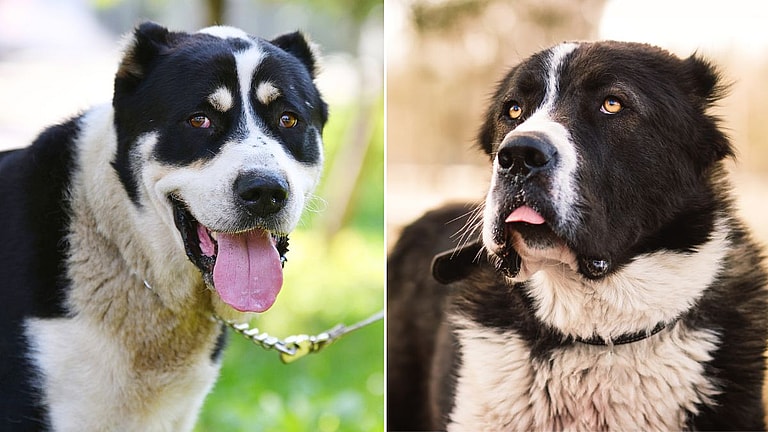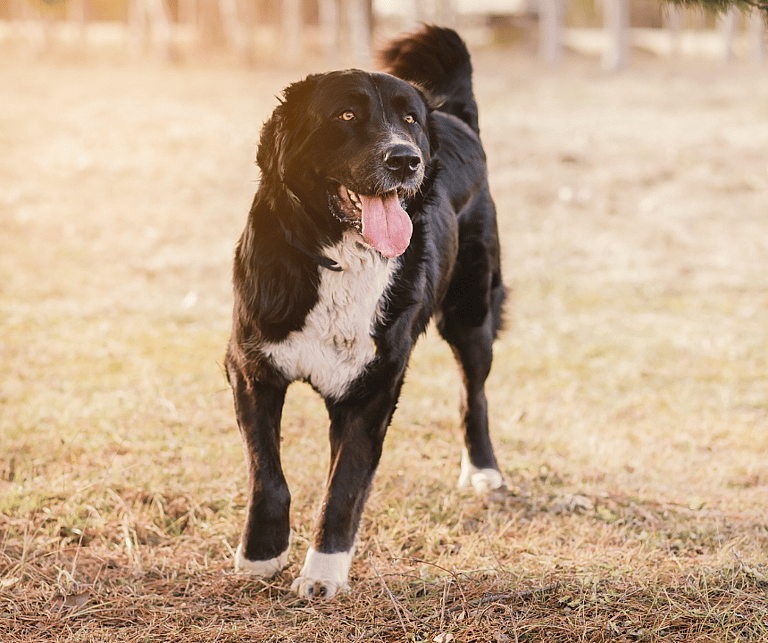This Dog Was Bred by Mother Nature. Meet the Alabai, the Central Asian Shepherd
The vast majority of modern dog breeds were deliberately created by humans who bred them for specific physical and psychological traits. For example, modern Border Collies are the result of decades of careful selection and standardization—humans molded the genetic makeup of the Border Collie to achieve an exact ideal.
Central Asian Shepherd Dogs—or Alabai dogs—weren’t bred to fit any human-made ideal. Natural selection shaped this dog breed, and Central Asian Shepherds are perhaps the oldest known indigenous dog breed group in the world. Records of Central Asian Shepherds can be traced back more than 5,000 years in their native regions throughout Central Asia from the Caspian Sea to Northwest China. Modern examples of the Alabai dog can still be found throughout Central Asia, but especially beloved in Turkmenistan, where it is their national breed!

So, what does it take to own a dog bred by Mother Nature? Let’s get to know the Central Asian Shepherd Dog and explore what life looks like for this ancient dog breed in the 21st century.
Meet 6 Alabai Dogs from Instagram
Central Asian Shepherd Dogs—AKA Alabai dogs—come in a wide range of colors, and can look quite different from one another. Remember that isolated groups of these dogs evolved to survive in their unique environments, so the breed has a fair amount of phenotypic diversity. Let’s meet a handful of Alabai dogs from Instagram; I suggest you soak it in because you might never meet this breed in person!
1. Max

Handsome Max is a black and white Central Asian Shepherd Dog from Poland! Like many Central Asian Shepherds, Max has his ears cropped super short and his tail bobbed—this used to be done for safety, to protect them against injuries while confronting or engaging large predators. Today, the choice to crop ears and tails is mostly an aesthetic choice.
2. Bruto

Bruto is a giant Alabai dog with a full natural tail and ears! Just four years old, Bruto is still a young pup with a super sweet personality that doesn’t match his intimidating appearance.
3. Azia

Even Central Asian Shepherd puppies look a little intimidating! Azia is a gorgeous Alabai from Slovakia. She’s all grown up now, but how irresistible was she as a puppy?
4. Draco & Sansa

Draco (left) and Sansa (right) are two giant Alabai dogs from Georgia state who are best buddies! These two are a great example of the differences between Central Asian Shepherds. Draco has long fur while Sansa has short fur, so it’s possible that Draco’s ancestors lived in a cold region while Sansa’s lived somewhere warm.
5. Odin

Odin is a five-year-old Central Asian Shepherd Dog from New Jersey with an incredible coat of fur that makes him look a little like a bear! Odin is technically the “baby” in the family, but he’s an absolutely enormous dog.
6. Koko

Koko is a two-year-old Central Asian Shepherd Dog from Croatia with a happy-go-lucky playful personality! Koko always wants to be part of the action, and he’s a little less shy than the typical Alabai dog.
Central Asian Shepherd Dog Basic Info
Central Asian Shepherd Dogs go by many names—Alabai, Aziat dogs, Boribasar, Volkodav, Chuponi, Tobet, and Turmen Wolf-Hounds, to mention a few. Why so many names for one breed of dog?
There are multiple varieties of Central Asian Shepherd Dogs all categorized under one breed name. Each of these unique Central Asian Shepherd Dog variations evolved slightly different adaptations to help them survive and thrive in their native environments. All-purpose guard dogs who were used for protecting livestock, their human families, and property, Central Asian Shepherd dogs are still evolving.
The American Kennel Club (alongside other international kennel clubs) considers the Central Asian Shepherd Dog a foundation stock service breed, which is a breed group that allows room for changing breed standards. One group of Central Asian Shepherd Dogs—the Central Asian Ovtcharka (or Ovcharka)—have been standardized by human intervention enough that they are now considered distinct from the indigenous types still found throughout Central Asia.
Central Asian Shepherd Dog Temperament

Confident, reserved, and independent, Central Asian Shepherd Dogs have strong territorial instincts and innate protective instincts for their family members and homes. Alabai dogs form deep bonds with their humans and are fearless and quick to react to any perceived threat to their safety. As working dogs Central Asian Shepherds often operate alone or with one or two other dogs—wary of strangers and serious in the face of danger, these dogs won’t hesitate to take charge if they aren’t being closely monitored by their humans.
Not an appropriate dog breed for a first-time or inexperienced dog owner, even experienced dog owners and handlers may find the Alabai dog challenging. Slow to mature and difficult to train, Central Asian Shepherd Dogs prefer to act on instinct rather than following commands.
Unlike livestock guardian dog breeds, Central Asian Shepherd Dogs are more human-focused and don’t bond to livestock in a social or familial capacity. This can make some Alabai dogs selective of other dogs, and they aren’t recommended for families with cats or small family pets. Hardy and strong, Central Asian Shepherd dogs are built to withstand extreme climates and long hours of hard work.
Despite their remarkable stamina, Central Asian Shepherd Dogs only have moderate energy levels, and expend more effort being watchful and alert than they do on physical activity. Central Asian Shepherds like to have a job and are happiest when they can live in peaceful families that respect their physical space and autonomy. Because of their large size and strong instincts to protect, ownership of a Central Asian Shepherd Dog requires you to create accommodations to keep everyone—including unexpected visitors—safe.

Central Asian Shepherd Dog Size
An extra-large dog breed, the biggest Alabai dogs top the scales at more than 100 pounds. On average, Central Asian Shepherd Dogs stand 25–28 inches tall and weigh 88–110 pounds.
Central Asian Shepherd Dog Health
Because Alabai dogs have historically been bred with minimal human intervention, this breed has very few inherited genetic ailments. However, like many large dog breeds, the Central Asian Shepherd Dog is prone to joint problems like:
- Joint issues (e.g. hip and elbow dysplasia)
- Back problems
- Bloat
- Heart disease
Where To Find An Alabai Dog For Sale

Finding a Central Asian Shepherd Dog for sale in the United States can be quite difficult since the breed is rare outside of Europe and Central Asia. If you’re certain this unique heritage dog breed is right for you, I recommend searching the American Kennel Club breeder marketplace for Central Asian Shepherd breeders. Joining online forums or breed clubs can also help to connect you with reputable Alabai dog breeders, but remember that your search could be lengthy.
Breeding dogs that have been naturally adapting to their indigenous climates for thousands of years is quite an undertaking. US breeders are far from the source of these native dogs, which can make finding a puppy a challenge.
Central Asian Shepherd Dog FAQ
We can’t fit thousands of years of heritage into one blog, but we’ll do our best to answer the most common questions about the Central Asian Shepherd Dog—no matter how niche!
Do Alabai dogs shed?
Yes. Alabai dogs have thick double coats that shed moderately year-round.
Do Alabai dogs bark a lot?
No. Alabai dogs are most likely to bark as an alert or warning and are not particularly vocal dogs. Some individuals with heightened reactivity may be more vocal, but the breed is not known for excessive barking.
How much do Central Asian Shepherd puppies cost?
Compared to other giant dog breeds, Alabai dog prices might seem a little low, but don’t let that fool you into thinking it will be easy to get one! The average Central Asian Shepherd Dog price starts at around $1,500–$2,000, but because this is a rare breed you should expect to possibly pay more.
Are Alabai dogs dangerous?
No—Alabai dogs are not inherently dangerous, but they are large, powerful dogs with strong protection instincts. This breed should always be closely monitored, and introductions to new people or animals should be taken slowly.
What is the Alabai dog bite force?
Alibi dogs have a bite force of around 500 PSI.
Are Kangal Shepherds or Alabai dogs stronger?
Kangal Shepherds are thought to have the strongest bite force of any dog breed at around 700–750 PSI. If we are considering bite force alone, Kangal Shepherds are stronger than Alabai dogs, but determining overall strength is a difficult task. Suffice it to say, that both of these breeds are powerful and built for taking on large predators.
What is the best kind of dog food for a Central Asian Shepherd Dog?
Central Asian Shepherd dogs should eat a balanced canine diet, similar to the diet of any other dog. Because of their size, Central Asian Shepherd dogs eat quite a lot, so keep in mind that feeding this breed is an expense in and of itself.



